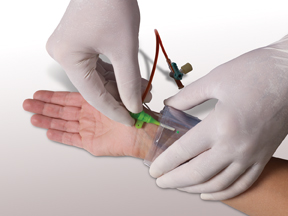 What is Transradial Cardiac Catheterization?
What is Transradial Cardiac Catheterization?
Transradial Cardiac Catheterization is an innovative wrist access cardiac catheterization technique.
The transradial technique is gradually gaining popularity, and is in fact, the primary mode of access in some select hospitals in the United States. In particular, patient comfort is increased with early ambulation possible, often allowing earlier hospital discharges. The incidence of access site vascular complications is also greatly reduced, even with the concomitant use of anticoagulants or antiplatelet agents.
Dr. Villa offers this cardiac catheterization technique that uses the patient’s wrist (radial artery) to access blood vessels leading to the heart, rather than in the groin area.
Most patients who have undergone cardiac catheterization from both the leg and wrist will strongly prefer the transradial route. Dr. Augusto Villa own experience demonstrates transradial access for coronary angiography or angioplasty to be a safe, effective and elegant alternative to transfemoral access, and is suitable for a wide variety of patients.
There are approximately 1.2 million Cardiac Catheterizations done in the U.S. each year. Cardiac Catheterization is used as a tool to diagnose and treat certain heart conditions utilizing a thin plastic tube (known as a catheter) that is inserted into an artery or vein and then can be advanced into the chambers of the heart or into the coronary arteries. Traditionally the catheter is inserted through the patient’s groin area, but interventional cardiology specialists like Dr. Villa, said that cardiac catheterization through the wrist can be better for some patients.
Inserting the catheter into the patient via a small hole in the wrist, rather than through the groin area is a great advancement for older or obese patients, and for those who have sleep apnea, vascular disease, or poor leg circulation. It’s also excellent for patients with back and spine issues, who can’t lie on their back during a procedure.
For appropriate patients, the radial (wrist access) approach results in reduced bruising, bleeding, and complications. Most patients can sit up and walk immediately after the procedure and may have a faster recovery period overall.
The radial (wrist) catheterization procedure has been shown in studies in to lower bleeding and vascular complications from 58 percent to 73 percent. However, despite these positive statistics, the radial procedure is only used in the United States 1 percent of the time while it is used about 50 percent in Europe, Canada and Japan. The wrist access procedures performed in the U.S. are done primarily at leading heart centers. However, as physicians become more familiar with the benefits of wrist access, we expect to see it being used more often.
